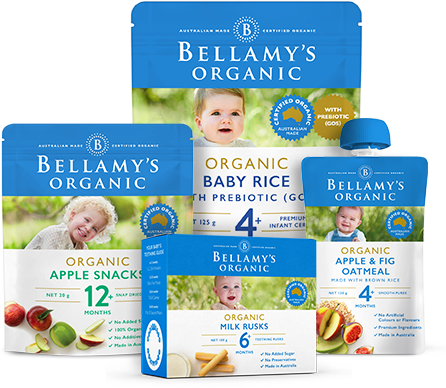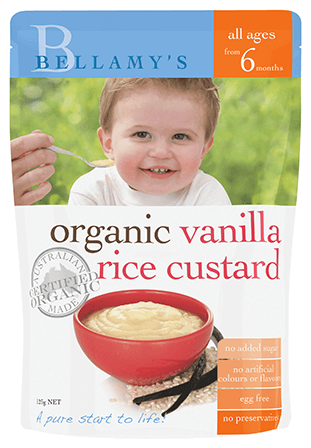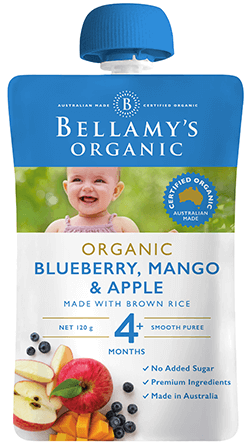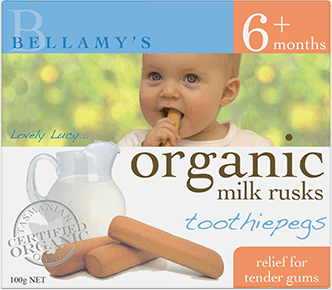An Ultimate Guide to Choosing an Infant Care Centre in Singapore
Choosing a child care centre for your little one is an important decision. If you are putting your child into ...
Read MoreImportant notice to customers — product packaging changesLearn More
NEW FOOD PACKAGING IN STORE NOW
From August 2018, customers will notice our rebranded food packaging start to appear on shelf in all major stockists.
 CURRENT Packaging
CURRENT Packaging

 new Packaging
new Packaging
We are excited to announce our new packaging will start to appear on shelf from August 2018. This transition to new packaging will occur over a number of months. During this time there will be a mix of current and new packaging on shelf.
There are no major changes to these products, in some instances there is a small name change or slight recipe improvement, see below for the full details.
Products purchased via the website will be delivered to customers in our old packaging until the end of October. From November, products ordered from the website will be delivered in the new packaging.
Please note, our Infant Formula packaging will not be rebranded until later in 2019.
For any questions, connect with our team of accredited practising Dietitians on +61 3 6332 9200
Product name changes
 CURRENT Packaging
Organic Baby Rice
CURRENT Packaging
Organic Baby Rice

 NEW Packaging
Organic Rice with Prebiotic (GOS)
Note: Our Baby Rice recipe has been upgraded to now include GOS Prebiotic
NEW Packaging
Organic Rice with Prebiotic (GOS)
Note: Our Baby Rice recipe has been upgraded to now include GOS Prebiotic
 CURRENT Packaging
Organic Vanilla Rice Custard
CURRENT Packaging
Organic Vanilla Rice Custard

 NEW Packaging
Organic Milk & Vanilla Baby Rice
NEW Packaging
Organic Milk & Vanilla Baby Rice
 CURRENT Packaging
Organic Apple & Cinnamon Porridge
CURRENT Packaging
Organic Apple & Cinnamon Porridge

 NEW Packaging
Organic Apple & Cinnamon Baby Porridge
NEW Packaging
Organic Apple & Cinnamon Baby Porridge
 CURRENT Packaging
Organic Banana, Pear & Mango
CURRENT Packaging
Organic Banana, Pear & Mango

 New Packaging
Organic Banana, Pear, Apple & Mango
New Packaging
Organic Banana, Pear, Apple & Mango
 CURRENT Packaging
Organic Mango, Blueberry & Apple
CURRENT Packaging
Organic Mango, Blueberry & Apple

 New Packaging
Organic Blueberry, Mango & Apple
New Packaging
Organic Blueberry, Mango & Apple
 CURRENT Packaging
Organic Peach & Apple
CURRENT Packaging
Organic Peach & Apple

 New Packaging
Organic Grape, Apple & Peach
New Packaging
Organic Grape, Apple & Peach
 CURRENT Packaging
Organic Pumpkin & Tomato Risotto
CURRENT Packaging
Organic Pumpkin & Tomato Risotto

 New Packaging
Organic Pumpkin, Sweet Potato & Tomato
New Packaging
Organic Pumpkin, Sweet Potato & Tomato
 CURRENT Packaging
Organic Broccoli, Beef & Brown Rice
CURRENT Packaging
Organic Broccoli, Beef & Brown Rice

 New Packaging
Organic Beef & Vegetables
New Packaging
Organic Beef & Vegetables
 CURRENT Packaging
Organic Milk Rusks Toothiepegs
CURRENT Packaging
Organic Milk Rusks Toothiepegs

 New Packaging
Organic Milk Rusks
New Packaging
Organic Milk Rusks
With the impact of Covid-19 on working parents, how can we effectively help our toddlers learn and grow whilst juggling our full-time jobs at home?
The Covid-19 pandemic has been raging across the world for over a year now, with many still trying to adapt to the “new normal” for both home and work life.
With this comes novel challenges for many parents. Not only do we have to contend with the pressures of working from home, but we also have to deal with our children’s unique needs as kindergartens, childcare centers, and schools are forced to shut their doors or operate at less capacity
Impact on parents
In Singapore, this can be rather challenging, with the fluctuating regulations.
Mothers, especially, are burdened more than fathers, despite both parents being equally saddled with work. Domestic and childcare labor frequently falls on women rather than men, translating into higher anxiety levels for them.
While most parents are fine with keeping their children in virtual learning, many are still concerned with how this will impact their careers and job security, as work-from-home (WFH) parents have to juggle taking care of their children whilst still attending to their daily work responsibilities.
Marketing Manager Ann, 28, who has been WFH since Covid-19 measures started, shared the challenges she faces with her 3-year old son, Ryan. Her husband, Alan, 30, sometimes has to work night shifts as his clients are largely based in the US.
“Not only do I have to be at work, but I also have to handle groceries and the house, while also seeing to Ryan’s needs for most of the day, when he’s not virtually learning with his peers. Sometimes I’m needed for an important 9 am zoom meeting, and he’d throw a tantrum because I wouldn’t be available to play with him”, she shared.
Usually, by that time, Ryan would already be at his childcare and occupied with fun activities so he wouldn’t feel restless and bored. While Ann understands how he feels, it does heavily impact her work because she’d be distracted by the noise and worrying.
“Sometimes I wish employers could understand the challenges parents with young children like me face, and not penalize us for the occasional lapse with our duties. Not all of us are privileged enough”, she frustratedly added.
Impact on young children
It’s not just us adults who are affected, however – young children can especially be emotionally, physically, and mentally affected too. Children are at risk of missing out on crucial childhood development factors, such as social contact and interactions and a structured learning environment, as they adjust to virtual learning instead.
This can be especially tough for toddlers, as a lot of stimulation and hands-on playtime are essential to developing their intellectual and cognitive development, whereas social contact is important for the development of their social and communication skills.
For 32-year old Izzie and her husband Ismail, the WFH order impacted them and their 4-year old daughter, Maria, a little differently.
Prior to the lockdowns, Maria was cared for by their live-in domestic worker, Rafaela, as the couple would usually be at work from 9 am to 7 pm.
Adjusting to the WFH situation wasn’t particularly difficult for them, but it did open their eyes to how tough it was for Maria to adjust to a different environment and schedule.
“She is a very talkative and social girl and has always been that way. It pains us to see that, since covid measures, she has been more withdrawn and quiet, and would sometimes respond with irritation to everyone in the house. We know our little girl is suffering”, said Ismail, despondently.
“After talking to her, we realized that she badly misses her friends, Aina and Dashveen, and Mrs. Tan, her favorite teacher. We didn’t really know what to do, and we’re tied up with work and unable to spend as much time with her as needed.
Aside from requesting that their parents allow her friends to facetime each other after classes, their busy schedules made it challenging to find a regular, mutually agreeable time.
“It’s really tough on the kids, and I really wish that everyone in the country could cooperate so our lives could resume with some semblance of normalcy. If not for us adults, then at least for our children.”, sighed Izzie.
Resources for WFH parents with toddlers
As in the above two stories, WFH with young children can be quite a challenge. So how can you stay on top of your children’s wellness and learning, then?
The key is to find a sweet spot between work and domestic responsibilities and foster an organized, structured environment at home, such as a weekly roster for both parent and child. Tools such as an organizer, timers, and a printed schedule on the wall can go a long way.
You and your spouse should split responsibilities equitably, and manage time appropriately. For single parents, consider enlisting the help of relatives or neighbors for short periods of time.
Here at Bellamy’s Organic, we’ve curated a list of online resources across multiple platforms that may help you keep your toddlers healthy, happy, and engaged at home.
1 – Scholastic Home Learning Packs
Scholastic, known for its educational books, has a section providing a wide range of home learning packs for toddlers. Access to all of these packs is free, although you will need to own the books first, which are available on their website, or on local online bookstores such as Kinokuniya Singapore.
Platform: PDF worksheets
Price: Free
2 – Quizlet
Quizlet has content in the form of interactive flashcards for all ages across all types of learning. Students can learn from flashcards and also be tested on their learning. From numeracy to spelling and even languages (such as Mandarin), Quizlet is a platform for learners and educators alike, where users can upload learning packs for others to use. While it takes some time to get used to the site, it’s more than worth it due to the sheer number of free resources available.
Platform: Web browser
Price: Free (with Premium features for paid users)
3 – Lego Duplo World
The app contains multiple mini-games based around the Lego Duplo blocks. It’s great for helping toddlers learn numbers 1 – 10, colours, and height, as well as improve impulse control and working memory. Although it is designed for an iPad, the app is available on Google Play with a monthly Google Play Plus subscription.
Platform: Mobile app (Google, Apple)
Price: Free (with paid level upgrades)
4 – ABCMouse.com
ABCmouse is a mobile app that covers reading, math, art, music, and more for kids aged 2 to 8. Created by teachers and education experts, it has over 10,000 activities for children at all academic levels.
Platform: Mobile app (Google, Apple)
Price: 30-day free trial, subscription at ~SGD 12.99/month (USD 9.95) or $59.99/year thereafter
5 – Canva Remote Learning Resources
Being organised will greatly help parents balance their time with work and children. Canva is a website well-known for its free graphic tools and templates for everyone to design what they need. Canva’s nifty Remote Learning section can help educators and parents alike with resources on distance learning and templates for creating attractive daily or weekly schedules for all.
Platform: Web browser
Price: Free
Moving forward
With new challenges come novel innovation and adaptation, two aspects that have allowed the human race to thrive for the millennia.
The pandemic may rage on, and it might be years before the world can ease up on movement restrictions, but growth and learning don’t have to stop.
Having all parents or caretakers engaged with their children in a structured manner daily can foster closer parent-bonds, which will pay off in the long run.
It is thus essential that parents and caretakers, especially fathers, split household and childcare responsibilities equitably for a more balanced and less stressful experience at home for all.
References
Article originally published on https://www.bellamysorganic.com.my/blog/juggling-work-and-kids-during-a-pandemic/